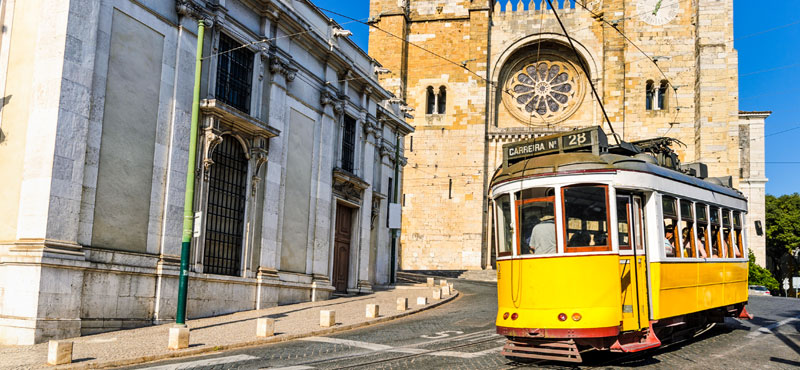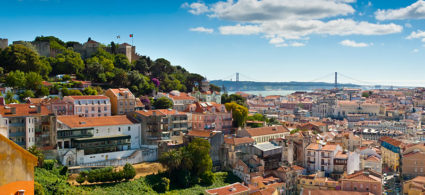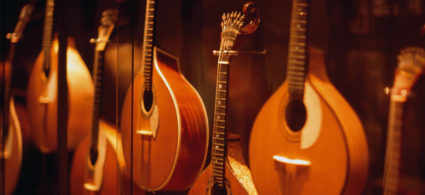

Located between São Jorge Castle and the Tagus river, the Alfama district preserves the traditional soul of Lisbon. It is a picturesque neighborhood made of ups, downs and a series of houses perched on its sloping alleyways; sometimes the houses are so close that they seem to be touching each other.
In order to explore the Alfama district do not follow any itinerary; just get lost among alleyways, streets, squares, staircases, small gardens, and panoramic terraces.
Being one of the less affected areas after the devastating earthquake of 1755, Alfama represents the historic heart of the city; it is that place where time seems to be suspended and where Lisbon reminds of the times before the earthquake. Popular houses with clothes hanging from the balconies alternate with elegant Manueline palaces and with the remains of the old Jewish district.
This neighborhood is also the cradle of fado, the traditional and moving music of Lisbon. Have a magic night eating at one of the many traditional fado houses around the neighborhood. Enjoy the sound of romantic and melancholy notes during your dinner.

Perched on the top of a hill, the medieval Sâo Jorge Castle dominates the city from above. The view from here is majestic and comforting at the same time.
By visiting the castle you will have the opportunity to admire: the fortress built by the Moorish in the XII century, the ruins of the old royal palace, archeological digs, and a 360° live view above Lisbon. You can walk along the tree-lined avenues of the castle and stop at one of the many panoramic points from where you can enjoy a breathtaking view.

The most important catholic religious site of the city of Lisbon is its Cathedral known as Sé Patriarcal or simply Sé.
The church is an incredible mix of French romanic and gothic style; its massive towers stand high in the sky while its interior, which is simple and austere, is home to the tombs of the king and benefactors of the city.
The Church of Santo Antonio da Sé, which is less known than the Cathedral, was built towards the end of the Eighteenth century on the remains of the birthplace of Saint Anthony of Padua. The Saint was from Lisbon; however, in Italy his name is associated to the name of the city where he died.
The miradouro, or panoramic viewpoints, are some characteristic elements of Lisbon; from the miradouros you can admire the whole city. In the Alfama district there are two miradouros: the Miradouro de Santa Luzia and the less famous Miradouro das Portas do Sol4, located a little bit higher.
The Il Miradouro de Santa Luzia5 is located next to the small homonymous chapel and it overlooks the Tagus river, the moorish walls, and the roofs of the Alfama district. It is a pretty large terrace featuring bushes, benches, and a covered walkaway decorated with colorful azulejos.
Located inside a palace from the 17th which is now home to the Superior School of Decorative Arts, the Museum of Decorative Arts of Lisbon exhibits a collection of decors and furnitures that will take you straight into the elegant homes from the 17th until the 20th century.
Discover Alfama through the eyes of expert guides who will take you on a tour of the city's hidden treasures. Participating in a free tour will allow you to capture the true essence of Alfama.
The free tours are a viable alternative to traditional guided tours. They work like this: participation is free and at the end of the visit you can leave a tip at your discretion. Below you will find our favourite free tour, otherwise you can see the full list by visiting this page.
Due to the number of traditional taverns offering live music, the Alfama is known as the “fado district“; this is by far the best area if you want to listen to a moving concert of traditional Portuguese music.
The Alfama is also the birthplace of one of the biggest fado singers of all times, Amália Rodrigues; during her 60-year-career she managed to take fado to its highest expression and to make it famous all over the world. Her extraordinary voice was compared to the one of great international artists like Ella Fitzgerald and Maria Callas.
Attending a fado concert in the city that gave birth to this music genre is a unique experience; not all music genres manage to touch the heart of people with such intensity.
Some recommended bars where to listen to some fado:
If you feel like learning more about this music genre visit the Museu do Fado, a permanent exhibition located near Sâo Jorge Castle where you have the opportunity to learn more about the history, the protagonists, and the main peculiarities of this traditional Portuguese music.
You will have the opportunity to admire historical documents, stage costumes, and other personal objects of the greatest performers who have shaped the history of fado.
There are different ways to get to the Alfama district, these are some of the most interesting ones:
The most fascinating and fun way to get to Alfama is by exploring it aboard the historical tram 28, which passes through the narrow streets of the neighborhood.
City Card allow you to save on public transport and / or on the entrances to the main tourist attractions.




